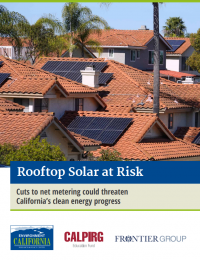Sharply reducing net metering payments and imposing high, solar-only fixed charges could slow the growth of rooftop solar installations – and, in the most extreme cases, could cause installations to plummet – according to a new report from Environment California Research & Policy Center, CALPIRG Education Fund and Frontier Group.
The report comes as the California Public Utilities Commission (CPUC) considers changes to the state’s net metering program, which compensates solar owners for the excess electricity they sell back to the grid.
“California needs continued growth in rooftop solar to reach our clean energy goals,” says Laura Deehan, state director at Environment California Research & Policy Center. “The drastic changes to solar compensation that the CPUC is considering threaten to throw California’s rooftop solar leadership off a cliff.”
The report, Rooftop Solar at Risk: Cuts to net metering could threaten California’s clean energy progress, highlights multiple case studies on how solar compensation affects installation rates. Several studies examined California’s publicly owned utilities, which are not required to follow the CPUC net metering policies, showing that reduced compensation had put the brakes on solar power deployment.
In Arizona, Salt River Project adopted new fees and policies for rooftop solar that nearly doubled the payback time of solar projects. Solar adoption declined between 50 percent and 95 percent after the changes were made.
Nevada’s 2016 cut to net metering compensation was followed by a 47% reduction in residential solar installations over the next year. Nevada eventually reinstituted net metering.
The Imperial Irrigation District in California abandoned net metering in July 2016, causing residential solar installations to decline by 88 percent, while the Turlock Irrigation District in California ended net metering at the beginning of 2015. Within two years, annual residential solar installations had declined 74 percent.
California law commits the state to reach 100 percent clean electricity by 2045. To achieve that, state officials estimate that the state will need 39 GW of customer-sited solar, nearly quadrupling current distributed solar capacity in California.
“Rooftop solar is cheaper, more efficient and within the reach of more Californians than ever before,” says Jenn Engstrom, CALPIRG Education Fund state director. “California has so much to gain from investing in rooftop solar on our homes, schools and businesses, but the utility proposal to gut net metering effectively pushes rooftop solar out of the market.”
Pacific Gas and Electric, Southern California Edison and San Diego Gas & Electric are proposing to impose the nation’s highest fixed charges for solar customers, while simultaneously slashing the net metering payments that solar customers receive.




